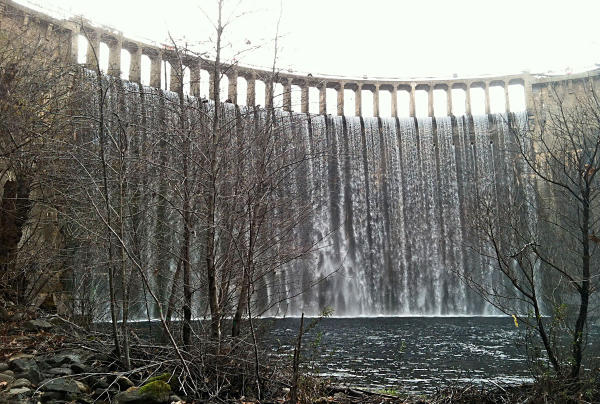Floods Reshaped California's Carmel River After Dam Removal, May Help Migrating Salmon
  |
Fisheries Ecology Division
The 2015 removal of San Clemente Dam in California restored natural processes to the Carmel River. The river’s response to the dam removal so far has played out largely through episodic floods that reshaped the river channel in California’s Mediterranean climate, scientists report.
That contrasts with dam removals on Pacific Northwest rivers such as in the Elwha River basin, where regular high flows over the course of each year were enough to rework the river channel. Following years of monitoring, Scientists from NOAA Fisheries’ Southwest Fisheries Science Center, the U.S. Geological Survey, and California State University Monterey Bay published their findings in the scientific journal, Earth Surface Processes and Landforms.
The dismantling of San Clemente Dam in association with rerouting the Carmel River was the largest dam removal in a climate dominated by highly variable and sometimes exceptionally wet winters, and more predictably hot, dry summers.
In the rainy and wet Northwest, typical spring floods were enough to rework the Elwha River’s channel to create improved habitat for fish. In the more variable and drier climate of California, occasional floods did most of the work on the Carmel River. The contrast demonstrates that “the timing, magnitude, and overall trajectory of how these rivers respond is dependent upon climate, landscape, and streamflow magnitude,” the scientists wrote.
“We found that large, infrequent floods were a key ingredient for triggering the geomorphic and habitat responses, which were anticipated results of the dam removal,” said lead author Lee Harrison, research hydrologist at NOAA Fisheries’ Southwest Fisheries Science Center. “The role of floods in driving geomorphic changes is likely to be highly important in other semi-arid river systems like the Carmel River.”
Dam removal “is one of the largest single restorative actions we as a society can take to aid in the recovery of” salmon and steelhead, said George Pess, a leading expert on river ecosystem response to dam removal at NOAA Fisheries’ Northwest Fisheries Science Center. “Monitoring and quantifying the response to such actions is critical, particularly in the early stages of such recovery actions.”
The new research “addressed important gaps in dam removal research by documenting physical and biological responses in a Mediterranean climate,” said Mathias Collins, from the NOAA Restoration Center, and an expert on river response to dam removals. “Many of us have been captivated by findings from dam-removal studies that suggest much of the sediment erosion in former impoundments is almost flow-independent in the early stages. But Harrison and colleagues are helping to define the potential geographic limits of those results, and show how hydroclimate matters to geomorphic disturbance response.”
Removal of the dam improved passage for endangered Southern California Coast steelhead native to the river, but even more importantly, restored the physical and ecological processes such as erosion and deposition that helps create and maintain habitat for the fish in the long term.
“In the Carmel River we are watching the re-establishment of gravel and stream channel characteristics required for all life stages of steelhead both downstream and upstream of the former dam,” said Tommy Williams, a fisheries ecologist at NOAA Fisheries’ Southwest Fisheries Science Center and a co-author on the study.
In the spring following removal of San Clemente Dam, adult steelhead began spawning in the river above the former dam. Scientists also observed Pacific lamprey upstream of the dam location for the first time in more than 20 years, Williams said.
The scientists concluded that the unique hydroclimate of each river determines how they will respond to dam removals, which should be considered in future planning.
Photos illustrating the San Clemente Dam on the Carmel River, CA just before (above) and several months after (below) removal. Photo credit: Joshua Logan, USGS.
Read the scientific paper:
River response to large-dam removal in a Mediterranean hydroclimatic setting: Carmel River, California, USA
by Lee R. Harrison et al.
Earth Surface Processes and Landforms (in press, published online June 2018)
DOI: 10.1002/esp.4464
Contact: SWFSC Fisheries Ecology Division, Landscape and Seascape Ecology Team


 Advertising
Advertising